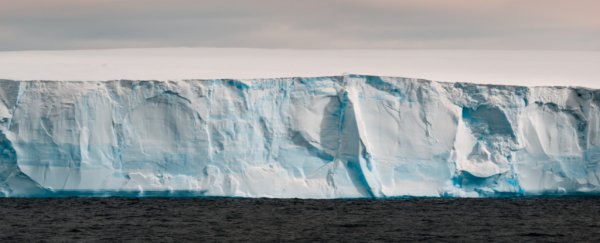A mineral that repeatedly turns up on Mars has been found in perhaps the last place on Earth you might think to look.
Deep - really deep - in the Antarctic ice, scientists have found jarosite, a tawny-hued mineral that's rarely found on Earth, but seems to be curiously abundant on the red planet.
This, the researchers said, solves the mystery of how jarosite formed on Mars - a problem that has perplexed scientists since the mineral was discovered by the Opportunity rover in 2004.
The discovery suggests that both Antarctic and Martian jarosite formed the same way: when dust containing the right mix of elements becomes trapped in ice, creating just the right conditions to transform into jarosite.
 The jarosite crystals found in Antarctic ice. (Baccolo et al., Nature Communications, 2021)
The jarosite crystals found in Antarctic ice. (Baccolo et al., Nature Communications, 2021)
The possibility of jarosite on the surface Mars was first raised in 1987, in spite of its rarity on Earth. When Opportunity did finally confirm its presence years later (backed up by subsequent detections by Spirit and Curiosity) the discovery was tremendously exciting, since jarosite can't form without water.
The context, however, was puzzling. The mineral appeared in fine-grained layered sediment formations, which made it difficult to work out how it was made.
That's because jarosite - a hydrous sulfate of potassium and iron - also needs, along with those elements, acidic conditions, as well as just the right ratio of water. Too much, and the mineral transforms into something called goethite.
Here on Earth, jarosite can form via the interaction of sulfuric acid with groundwater, so most of the hypotheses suggested that the jarosite had formed in evaporative lake basins, or through volcanic processes.
But that might not have been possible. Mars' crust is predominantly basalt, the alkalinity of which should quickly neutralise any acidic solutions that come into contact with it.
Since Mars is known to have previously experienced glacial periods - at least five, according to recent research - the possibility that the jarosite had formed from dust trapped in ice deposits had also been raised. According to this model, the concentration of sulfur-rich volcanic aerosols trapped in the ice would promote the acidic weathering of the dust, leading to the formation of jarosite.
This jarosite formation mechanism had never been observed anywhere else in the Solar System… until a team of researchers led by Giovanni Baccolo of the University of Milano-Bicocca in Italy studied a 1,620-metre (5,315-foot) long ice core sample called TALDICE from the Talos Dome in East Antarctica.
Taken from deeper than 1,000 metres (3,281 feet) below the ice, the sample contains small but significant amounts of jarosite, confirmed using scanning transmission electron microscopy and energy dispersive X-ray spectroscopy, the team found.
Given that the ice at these depths has been undisturbed for thousands of years (the oldest, deepest part of the sample has been dated to at least 250,000 years old), and that the crystals showed signs of chemical weathering consistent with this environment, the team believes that the mineral formed there, and didn't arrive from elsewhere - for example, via meteorite. (Jarosite-bearing meteorites have found their way from Mars to Earth.)
"Based on our understanding of the environmental conditions of deep ice, we interpret jarosite as the product of englacial weathering," the researchers wrote in their paper.
"Its formation requires acidic conditions, a limited activity of liquid water and the presence of iron-bearing materials. The deep part (>1000 m) of TALDICE can meet such requirements."
In turn, this finding validates the glacial formation of jarosite on Mars. The environment deep in the Antarctic ice, far removed from Earth's atmosphere, is a decent analogue for glacial Mars conditions, the researchers said, with both settings containing the ingredients for the jarosite formation.
When you consider Mars' repeated periods of glaciation, this formation mechanism could neatly explain the predicted ubiquity of the mineral across the entire planet.
There was a lot less jarosite found in the core sample than there is on Mars. Mars, however, is a lot dustier and has a lot more basalt than Antarctica. Future research and modelling could be used to determine if this combination would be sufficient to produce jarosite in the abundances expected on Mars.
The team's research has been published in Nature Communications.
